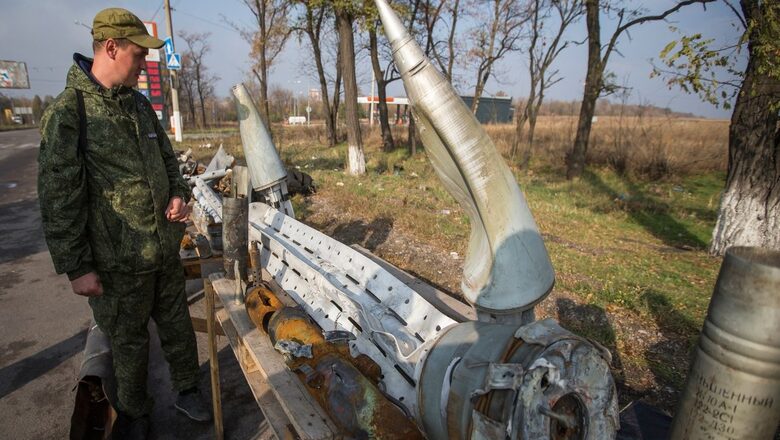
views
The impact of weapons on war outcomes, both in quantitative and qualitative terms, has always been a debatable proposition. On one hand, the supremacy of quality weapons was well established in the 1991 Gulf War that heralded the forceful debate on ‘Revolution in Military Affairs (RMA)’. On the other hand, the US, armed with the most sophisticated weapons in its kitty, could not win in Vietnam or Afghanistan wars. While many countries have been arming Ukraine with tanks, planes and heavy-duty artillery weapons, the Pentagon’s recent decision of providing cluster munitions reinforces the debate if weapons really matter.
The immediate decision to arm Ukraine with cluster munitions is driven perhaps by Ukraine’s diminishing artillery collection and stalemate on the war front. Also, Russia has been using them on a large scale against Ukraine. However, while the history of cluster munitions does establish its lethality through civilian deaths, both during and after the wars, its role in changing the war outcomes is yet to be established. For instance, cluster bombs were widely used in the Vietnam War in the mid-sixties to mid-seventies. As many as 260 million cluster bombs and bomblets were dropped, out of which 80 million failed to explode. Several thousands died. Yet, the deadly bombs could not change the war outcome in Vietnam. Similarly, large-scale usage of cluster munitions in subsequent wars, civil wars and secessionist conflicts failed to alter the fate of different conflicts.
Weapons engender international curiosity if they are the byproduct of ‘disruptive military innovation’ and considered ‘game changers’ in the war ecology. Warring nations as well as military industries find something new to bank upon for an edge in the warfare game. Such weapons quickly metamorphose into new currencies of military power. However, cluster munitions are based neither on ‘new technologies’ nor are the preserve of a few nations. They are also not a ‘winning weapon’ like the atomic bomb in the forties that changed the course of World War II. Instead, they have been used and abused by many nations; have led to a vast number of civilian casualties and are now subject to international regulations. Cluster munitions, without any doubt, do not enjoy a favourable position in public consciousness across the globe.
Yet, in widely marketing these bad weapons as genuine ‘military assistance’ to Ukraine’s war efforts, three mistakes are being made. First, too much importance is being given to weapons as an ‘independent variable’ capable of deciding the war outcome. Weapons, by themselves, do not win wars and have to be accompanied with other variables for efficacy. Hitherto, Russia enjoys asymmetrical preponderance in terms of weapons over Ukraine. But as the war developments exposed, Russian military leadership was poor along with its men on the ground. If Ukraine has managed a stalemate with Russia for more than 500 days, credit should go to its strategic instincts, motivated armed forces and force deployments in the war zone that provided it with an effective defensive strategy so far.
Second, cluster munitions belong to a fossilised technological generation and are less impactful compared to many new-generation weapons. In contemporary warfare, technologically advanced counter-defence mechanisms are available that minimise the impact of cluster munitions upon soldiers, if not civilians. Both Russia and Ukraine are quite familiar with the usage of the munition. Thus, it would only be a supply-chain supplement for Ukraine. Additionally, they are effective largely in heavily populated war zones of Asia and Africa. Continental Europe, on the other hand, is less populated. Therefore, cluster munitions may have diminished utility in the ongoing war.
Third, arming Ukraine with cluster munitions would induce a moral dilemma for many countries that otherwise support it with weapons and financial resources. Although most NATO members are still not signatories or state parties to the Convention on Cluster Munitions (CCM) – 2010, they would still find it difficult to speak for Ukraine. Further, 111 states are parties to CCM, and 12 are actual signatories. 146 countries supported the CCM resolution in the UN General Assembly last year. Therefore, the 11th Meeting of the State Parties to the CCM, slated on September 11-14 in Geneva, may probably take up the issue for discussion.
Hitherto, the Russia-Ukraine War has already metamorphosed into a ruptured battlefield where both sides have lost sense of weapons, technologies and manpower casualties. The protracted war would continue for quite some time with no outright victory for any side. Capture and recapture of territories would continue, irrespective of new supplies of cluster munitions to Ukraine. Publicised supplies of cluster munitions, however, would rob Ukraine of defensive positioning in the war and may reduce global support for its war operations. Probably, there are better ways of bolstering Ukraine’s severely strained armour and other supply-chain issues.
The author is in the Indian Defence Accounts Department. Views expressed are personal.




















Comments
0 comment